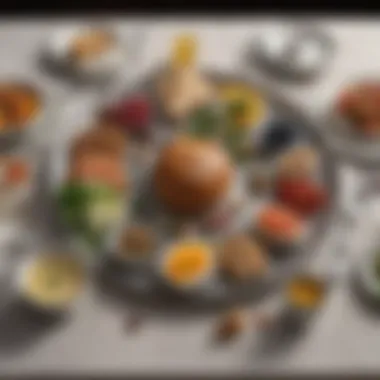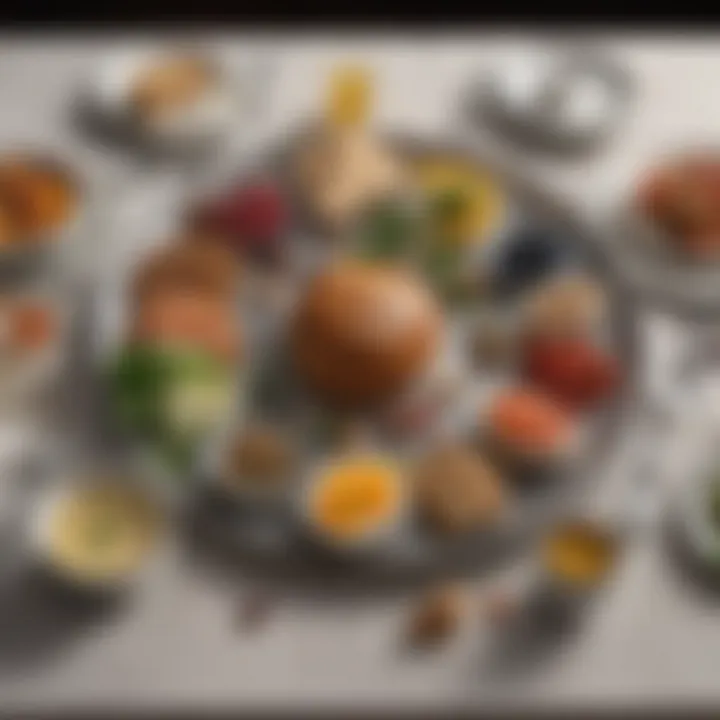The Rich History and Significance of the Seder Meal


Intro
The Seder meal, a cornerstone of Jewish tradition, offers much more than a simple dining experience. It is a profound ritual filled with historical significance and cultural relevance. The practices surrounding the Seder are layers of memory and meaning, woven together through generations. Each element of the meal serves a purpose, telling the story of liberation and identity.
In this article, we will explore the history of the Seder meal, highlighting its origins, the significance of its various components, and how it continues to resonate in modern Jewish life. The journey through its evolution reveals not only culinary diversity but also the deep-rooted traditions shared by Jewish communities worldwide.
Foreword to the Seder Meal
The Seder meal is a significant event that showcases the fusion of Jewish history, custom, and culinary tradition. It offers a platform for the Jewish community to engage in rituals that connect them to their ancestral narratives and highlight enduring cultural values. Understanding the Seder is crucial as it illustrates how food serves as a vessel for memory, identity, and faith. While the Seder is a festive meal, it is also deeply ritualistic, and exploring its elements sheds light on its wider implications.
Definition and Purpose
The term "Seder" translates to "order" in Hebrew. This reflects the structured nature of the meal, which follows a precise sequence of actions and readings. The primary purpose of the Seder is to commemorate the Exodus from Egypt, a pivotal event in Jewish history. During the meal, participants retell the story of slavery and liberation, emphasizing themes of freedom and resilience. The Seder serves both as a historical recounting and an educational opportunity, particularly for younger generations. By engaging with this narrative, attendees reinforce their cultural and religious identity.
The Importance of Participation
Participation in the Seder is not merely a passive act; it is a communal experience that facilitates learning and connection. Each person at the table plays a vital role, contributing to the overall atmosphere and the observance of traditions. Family and friends gather to ask the "Four Questions," sing songs, and share insights. This interactive component nurtures a sense of belonging and collective memory. Additionally, participation can extend beyond families; interfaith and inclusive Seders have emerged, allowing diverse groups to engage with the tradition. Creating a welcoming environment for discussion can deepen one’s understanding of the meal’s significance while fostering respect for different backgrounds.
Historical Context
The historical context of the Seder meal holds profound significance, as it provides an essential framework for understanding the rituals and components associated with this important Jewish tradition. By situating the Seder within its historical backdrop, one can appreciate the ways in which the meal has evolved over time, shaped by cultural influences and pivotal events. This section elaborates on two key components: the Exodus narrative, which serves as the foundation of the Seder, and ancient practices that thrived in the Land of Israel.
The Exodus Narrative
The Exodus narrative is central to the Seder meal, encapsulating the themes of liberation and remembrance that permeate the Jewish experience. According to the biblical account in the Book of Exodus, the Israelites found themselves enslaved in Egypt. This powerful story speaks to the struggle for freedom, as the Israelites endure hardship until God intervenes, leading them to liberation. This journey is commemorated through the Seder, where participants recall both the suffering and the eventual redemption.
The act of recounting the Exodus during the Seder reinforces the connection between past and present. It emphasizes the significance of memory within Jewish culture. This narrative is not merely historical; it resonates deeply with themes of oppression and resilience that hold relevance today. It encourages reflection on contemporary struggles against tyranny, allowing for a broader understanding of what it means to be free.
"The Seder is more than a meal; it's an immersive experience that invites all participants to engage with their heritage."
Ancient Practices in the Land of Israel
Before the formalization of the Seder, various practices regarding meal rituals existed in the ancient Land of Israel. Agriculture played a crucial role, informing dietary customs and seasonal events. Acknowledging local agricultural cycles influenced the festivities associated with Passover. Ancient Israelites, primarily agrarian in nature, celebrated the spring harvest and its significance in relation to their liberation story.
Over time, these practices introduced specific items into the Seder meal, establishing the Seder plate's elements. The bitter herbs, for example, symbolize the bitterness of slavery, while the charoset represents the mortar used in construction by the enslaved Israelites.
Additionally, various food items served as a way to engage the participants in the story, creating a multi-sensory experience. This tradition of participation connects contemporary Seder practices to their ancient roots, illustrating a continuity of faith, remembrance, and community.
Understanding the historical context enriches the experience of observing the Seder meal today. It provides insight into how the past shapes the present, revealing layers of meaning imbued in each ritual. The ways in which historical narratives have merged with traditional practices inform the ongoing importance of the Seder in Jewish life.
Development of Seder Traditions
The development of Seder traditions is crucial to understanding how this meal has transformed over centuries into its current form. Seder is not just a collection of rituals but an evolving expression of cultural and religious identity. Its traditions reflect the ways in which Jewish communities have adapted to various historical contexts, societal changes, and theological interpretations.


Close of the Second Temple Period
The close of the Second Temple period marked a significant shift in Jewish life and practice. After the temple's destruction in 70 CE, Jewish worship practices changed profoundly. The emphasis moved from sacrifices at the temple to home-centered observances. The Seder meal began to take on its ritualistic significance during this time. This transition highlighted the importance of family and community in religious observance.
The Haggadah, which guides the Seder, was compiled and formalized during this era. Many of the rituals we recognize today originated from this time. The directive to recount the Exodus narrative took on an essential role. Thus, the Seder became a means to instill historical memory and cultural identity in the Jewish population.
Influence of Rabbinic Tradition
The emergence of rabbinic authority further shaped Seder traditions. Rabbis played a pivotal role in interpreting Jewish law and adapting it to the new reality post-Temple. Their influence is evident in the structure of the Seder and the texts used. The Haggadah became a vehicle for rabbinic teachings, embedding ethical reflections along with historical narratives. This development highlighted the educational aspect of the Seder.
Rituals such as the Four Questions and the Afikoman were emphasized during this period to make the experience interactive. Encouraging questioning during the Seder promotes engagement among participants of all ages. Additionally, variations in the Seder across different Jewish communities reflect rabbinic interpretations, demonstrating the adaptability of Jewish tradition.
The development of Seder traditions shows how Jewish life is a dynamic tapestry woven through experiences, interpretations, and adaptations. These customs continue to connect generations, nurturing a sense of continuity, identity, and community in the practice of Judaism.
The Haggadah: The Central Text
The Haggadah serves as the backbone of the Seder meal, guiding participants through the rituals and readings that mark this significant Jewish tradition. At its core, the Haggadah provides a framework for the narrative of the Exodus, assisting in the transmission of history and values from one generation to the next. It is not merely a book; it encapsulates the theological principles and collective memories that define the Jewish experience.
In addition to its narrative function, the Haggadah fosters a sense of community. It invites dialogue and questions, embodying the essence of Jewish learning and reflection. The reading brings together family and friends, connecting them to their heritage. Through this shared experience, the importance of remembering the past becomes palpable.
"The Haggadah is more than an artifact; it is a living document that evolves with each generation's interpretation and practice."
Origins and Compilation
The origins of the Haggadah can be traced back to ancient Jewish texts and traditions. The earliest known versions likely emerged around the time of the Bar Kokhba revolt in the second century CE. These early texts aimed to outline the story of the Exodus and established essential procedures for the Seder meal. Over the centuries, various scholars contributed to its development, adapting it to the needs of their communities.
The first printed Haggadah appeared in the 15th century, but it was the 19th and 20th centuries that saw a significant enrichment of the text. Writers and annotators incorporated modern themes such as freedom and social justice. This evolution reflects contemporary struggles and aspirations, making the Haggadah relevant in a changing world.
Variations Across Cultures
The Haggadah differs widely across Jewish communities, reflecting cultural nuances and regional practices. Ashkenazi Haggadot often emphasize the historical aspects of the Seder, focusing on the narrative of the Exodus. In contrast, Sephardic Haggadot frequently incorporate rich poetic texts and songs. These variations enrich the Seder experience, showing the adaptability of Jewish traditions.
Furthermore, individual families may have unique customs that influence their version of the Haggadah. Personal stories, songs, and interpretations add layers of meaning, allowing each Seder to tell its own tale. Regardless of the specific variations, the underlying message of freedom and remembrance remains constant, demonstrating the Haggadah's enduring significance.
Components of the Seder Plate
The Seder plate is a central aspect of the Seder meal, where each item holds significant meaning. Understanding these components is vital to appreciating the Seder dinner and its deep historical and cultural associations. The Seder plate serves not only as a means of worship but also as a storytelling device that conveys the narrative of the Exodus and the long-standing traditions that accompany it.
Symbolism of Each Item
Each item on the Seder plate is rich with symbolism:
- Maror (Bitter Herbs): This is often horseradish, and it represents the bitterness of slavery. When consumed, participants recall the suffering endured by their ancestors in Egypt.
- Charoset: This mixture of apples, nuts, wine, and spices symbolizes the mortar used by the Jewish slaves to build storehouses in Egypt. Its sweet flavor contrasts with the bitterness of Maror, representing the hope for better times.
- Karpas (Vegetable): Typically parsley or celery, Karpas is a fresh green vegetable that represents spring and rebirth. It is dipped in salt water during the meal to symbolize the tears shed during slavery.
- Z'roa (Shank Bone): The roasted bone signifies the Paschal lamb, which was sacrificed during the Temple period. This serves as a reminder of the importance of sacrifice in Jewish tradition.
- Beitzah (Roasted Egg): The egg symbolizes mourning for the destroyed Temple and also represents the cycle of life.
- Chazeret (Second Bitter Herb): Often romaine lettuce, this serves a similar purpose as Maror, reinforcing the theme of bitterness in the Exodus story.
Regional Variations in Ingredients
Diverse cultures within the Jewish community have led to variations in the ingredients of the Seder plate. The items and their preparation may differ based on regional preferences and available ingredients:
- Ashkenazi Traditions: Commonly use horseradish for Maror and matzo meal for Charoset, with the flavor profile being more straightforward.
- Sephardic Traditions: Often incorporate different spices and fruits into Charoset, emphasizing complex flavors and textures. Ingredients may include figs, dates, or nuts, allowing for regional diversity.
- Yemenite Variations: Might use different herbs and spices for Maror, reflecting local tastes and traditions, which adds a unique twist to the traditional plate.


In summary, the components of the Seder plate are not merely food items; they carry historical weight and cultural significance. Understanding each element enhances the Seder experience, allowing participants to connect deeply with their heritage while engaging in traditions that have evolved across time and geography.
Rituals and Practices
In the context of the Seder meal, rituals and practices serve as the backbone of the evening’s observance. They are not merely actions but also vehicles for conveying deep historical and religious significance. Each ritual unfolds a narrative that connects participants to the vast heritage of the Jewish people, inviting reflection on themes of freedom, redemption, and faith. These rituals are designed to engage, educate, and unite families and communities, transforming a meal into a profound spiritual experience.
Four Questions
The Four Questions, or Ma Nishtanah, are a cornerstone of the Seder meal. Traditionally posed by the youngest participant, these questions challenge the norms of that evening. Each question highlights the distinct practices observed during Passover, urging diners to reflect on why these rituals differ from those in other times of the year. This act fosters a sense of inquiry and discussion, vital elements in Jewish education.
- Why is this night different from all other nights?
- On all other nights, we eat leavened or unleavened bread; why on this night do we only eat unleavened bread?
- On all other nights, we eat all kinds of herbs; why on this night do we eat only bitter herbs?
- On all other nights, we do not dip our vegetables even once; why on this night do we dip them twice?
These questions serve to instigate dialogue among guests, facilitating a deeper understanding of the Seder's narrative. The act brings awareness to the historical struggles of the Jewish people while fostering a strong sense of identity and continuity.
The Afikoman Tradition
The Afikoman is an integral part of the Seder, often capturing the attention of children and adults alike. The practice involves hiding a piece of matzah, called the Afikoman, after it has been eaten. Traditionally, children search for it later in the evening, and the one who finds it may negotiate a reward.
- Symbolism: The Afikoman represents the Passover sacrifice, linking the meal back to ancient Temple practices. The hiding and searching echo themes of seeking freedom and redemption.
- Family Engagement: This tradition heightens participation and excitement, especially for younger generations. It transforms an otherwise solemn meal into an interactive and memorable family event.
- Continuity and Innovation: There are numerous adaptations of the Afikoman tradition. Some families create unique hunts or puzzles, keeping the tradition fresh and relevant. This evolution serves to retain the core meanings while allowing for personal expression.
"Rituals like the Four Questions and the Afikoman not only maintain cultural continuity but also introduce new generations to their Jewish heritage and identity."
Through these rituals, participants gain an experiential understanding of their history. This rich tapestry of practices not only serves as a reminder of the past but also nurtures the community's future.
Modern Adaptations and Trends
Modern adaptations of the Seder meal provide invaluable insights into how traditions can evolve while retaining their core significance. This phenomenon of adapting rituals reflects not only changing societal norms but also the diverse needs of contemporary families. As global cultures increasingly intersect, the Seder meal serves as a canvas for creativity, where cooks blend traditional recipes with innovative culinary techniques and ingredients. These adaptations embody the essence of Jewish resilience and adaptability in the face of modern challenges.
Innovative Recipes in Contemporary Seder
Innovative recipes are redefining the Seder experience. Many individuals are embracing the culinary fusion by integrating fresh, seasonal produce and international flavors while respecting the traditional requirements. For instance, a classic charoset may now feature unique ingredients, such as tropical fruits or spices inspired from Middle Eastern cuisine. These innovations bring not only fresh tastes but also a deeper connection to the global Jewish community.
Some examples of modern Seder recipes include:
- Quinoa Kugel: A gluten-free take on the classic noodle kugel, using quinoa as a base ingredient.
- Herbed Potato Latkes: A contemporary twist on the fried potato cakes, incorporating herbs like dill or chives.
- Matzah Ball Soup with Lemongrass: This introduces an Asian flair to a staple dish, demonstrating how tradition can coexist with innovation.
These novel recipes often aim to cater to specific dietary preferences like veganism or gluten intolerance, making the Seder accessible to more participants. They not only revitalize traditional dishes but also encourage creativity among hosts.
Inclusivity and Interfaith Seders
Inclusivity is becoming an essential aspect of modern Seders. Many families now invite friends from various backgrounds to join their celebrations, facilitating interfaith dialogue and understanding. This practice expands the Seder’s reach beyond Jewish communities, fostering appreciation for cultural traditions and practices.
Inclusion can manifest in different ways, notably:


- Shared Rituals: Incorporating elements from different cultures, allowing guests to share their traditions related to springtime or renewal.
- Culinary Contributions: Inviting guests to bring dishes that resonate with them, which can lead to fascinating culinary exchanges.
- Educational Moments: Hosting discussions on the significance of each ritual, encouraging questions and reflections from all participants, regardless of their backgrounds.
"The Seder offers an open door for friendship and understanding, bridging gaps between communities in today’s diverse world."
These approaches not only enhance the Seder experience but also create a welcoming environment, fostering a sense of community among all participants. As a result, the Seder meal evolves, amplifying its relevance and significance in a modern context.
Global Perspectives on the Seder
The Seder meal holds significant value not only within Jewish traditions but also within its influences across the globe. Understanding global perspectives on the Seder provides insights into how diverse traditions and practices have enriched Jewish cultural identity. It underscores the evolution of the Seder through various socio-political landscapes, illustrating adaptability and continuity in the face of change. This section will delve into specific elements that illustrate distinct practices and celebrations in relation to the Seder across different communities around the world.
Distinct Practices in Ashkenazi and Sephardic Traditions
The Seder meal, while universally celebrated, manifests distinct characteristics among Ashkenazi and Sephardic Jews.
- Ashkenazi Traditions: Predominantly found in Eastern and Central Europe, Ashkenazi Jews have unique rituals. They often include matzo ball soup and charoset made with walnuts, apples, and sweet wine. Their prayers and songs might also differ, emphasizing Eastern European musical influences.
- Sephardic Traditions: In contrast, Sephardic Jews, originating from Spain, North Africa, and parts of the Middle East, have a different array of offerings. Dishes like citrus charoset and lamb used for the Seder plate are more common. Their melodies and prayers reflect Mediterranean influences, creating an entirely different atmosphere during the meal.
"Culinary traditions can deeply connect individuals to their heritage, making the Seder a multi-faceted experience that reflects diverse histories."
Both traditions reinforce cultural identity while demonstrating shared themes of liberation and remembrance.
Celebrations Among Diaspora Communities
The Seder meal takes on additional layers of meaning among Jewish diaspora communities. With historical migrations, the Seder has been adapted to fit local customs while maintaining its core significance.
- Cultural Adaptations: Communities in North America, for instance, might incorporate local ingredients or modify recipes to suit availability.
- Interfaith Inclusivity: This is evident in many diaspora communities, where the Seder is not exclusively a Jewish event but invites friends and neighbors from different backgrounds. This enhances community ties and promotes understanding.
Key Considerations for Diaspora Celebrations:
- Emphasizing inclusive themes in the Haggadah, elevating the message of freedom for all.
- Exploring regional variations in rituals and communal gatherings that reflect the local culture.
As the Seder continues to evolve within diaspora contexts, its enduring themes resonate deeply—connecting generations while fostering community relationships.
Finale: The Enduring Significance of the Seder
The Seder meal is much more than just a ritual; it embodies the living essence of Jewish history and identity. Each component of the meal is steeped in meaning, serving as a bridge between generations. The act of gathering around the Seder table promotes a sense of togetherness and continuity. This meal is a reminder of the Jewish people's resilience and commitment to their cultural heritage. It holds the power to connect individuals not only to their ancestry but also to each other, creating a profound feeling of community.
Moreover, the Seder stands as a testimony to the adaptability of Jewish customs throughout time. The various adaptations made to the Seder reflect broader societal changes and the evolving nature of cultural identity. This flexibility allows the Seder to remain relevant today, ensuring its importance across different generations and communities.
The Seder is not just an event; it is a living tradition that nurtures the cultural and religious identity of Jewish people.
Reflections on Cultural Identity
The Seder meal serves as a potent reflection of cultural identity for Jewish communities everywhere. It encapsulates shared narratives, symbols, and practices that define Jewish survival and continuity. Each family may interpret the customs differently, but the core stories and rituals remain universally accessible. This universality fosters a sense of belonging amidst the diversity within the global Jewish community.
The Seder also emphasizes the importance of education and understanding. The retelling of the Exodus story through the Haggadah promotes a deeper connection to one’s roots. Many families include discussions about contemporary issues during the Seder. This approach enriches the overall experience, allowing participants to draw parallels between past struggles and present realities. As such, the Seder is a vibrant space for cultivating awareness and fostering dialogue.
Future of the Seder Meal
As society evolves, so does the Seder meal. The future of this tradition lies in its ability to embrace change while keeping its essential spirit intact. Innovations in dietary preferences, such as veganism or gluten-free options, are being integrated into modern Seder meals. This adaptation reflects a broader trend of inclusivity, inviting diverse participants to engage with the tradition.
Additionally, interfaith Seders are becoming more common. In an increasingly multicultural world, these gatherings foster understanding and respect among different communities. By sharing the Seder experience with non-Jewish friends or neighbors, Jewish families promote dialogue and cultural exchange. This interaction ensures the Seder thrives beyond its traditional confines, resonating with a wider audience.







